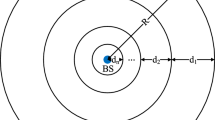Abstract
Due to the random deployment of Wireless Sensor Network (WSN) nodes in dangerous and inaccessible environments and their sensing radius limitations, complete coverage of the monitoring area cannot be achieved. Clustering techniques, applying the mobile nodes, and adjusting the sensing radius of sensor nodes are regarded as practical techniques to improve the coverage and reduce the energy consumption. The challenges including, how to grouping the nodes, selecting the cluster heads, managing the mobility of mobile nodes, and scheduling sleep intervals should be considered in the hybrid techniques to improve the coverage with minimum overlapping. In this paper, we propose a DEHCIC (Distributed Energy-aware Hexagon based Clustering algorithm to Improve Coverage) algorithm that considers energy and topological features such as the number of mobile neighbor nodes and number of neighbor nodes for electing the cluster heads. In addition, DEHCIC attempts to cover the holes as much as possible by the static sensor nodes so that if it is not possible, the closest mobile will cover the coverage holes. Moreover, the DEHCIC algorithm retains the sensor nodes in the active mode that cover the interest points; also, it puts others into the low-powered sleep mode. The simulation results show that the proposed algorithm reduces dependency on the movement of mobile nodes and with the minimum number of active nodes can prolong the coverage lifetime and improve the network coverage effectively.
















Similar content being viewed by others
References
Akyildiz IF, Su W, Sankarasubramaniam Y, Cayirci E (2002) Wireless sensor networks: a survey. Comput Networks 38:393–422. https://doi.org/10.1016/S1389-1286(01)00302-4
Babaie S, Khosrohosseini A, Khadem-Zadeh A (2013) A new self-diagnosing approach based on petri nets and correlation graphs for fault management in wireless sensor networks. J Syst Archit 59:582–600. https://doi.org/10.1016/j.sysarc.2013.06.004
Akbari Torkestani J (2013) An adaptive energy-efficient area coverage algorithm for wireless sensor networks. Ad Hoc Networks 11:1655–1666. https://doi.org/10.1016/j.adhoc.2013.03.002
Singh A, Rossi A (2013) A genetic algorithm based exact approach for lifetime maximization of directional sensor networks. Ad Hoc Networks 11:1006–1021. https://doi.org/10.1016/j.adhoc.2012.11.004
Hnaien F, Khoukhi L (2014) Sensor deployment optimization methods to achieve both coverage and connectivity in wireless sensor networks. Comput Oper Res 59:11–21. https://doi.org/10.1016/j.cor.2014.11.002
Wang Y, Wu S, Gao X et al (2017) Minimizing mobile sensor movements to form a line K-coverage. Peer-to-Peer Netw Appl 10:1063–1078. https://doi.org/10.1007/s12083-016-0469-9
Yu J, Deng X, Yu D et al (2013) CWSC: connected k-coverage working sets construction algorithm in wireless sensor networks. AEU - Int J Electron Commun 67:937–946. https://doi.org/10.1016/j.aeue.2013.05.004
Amgoth T, Jana PK (2017) Coverage hole detection and restoration algorithm for wireless sensor networks. Peer-to-Peer Netw Appl 10:66–78. https://doi.org/10.1007/s12083-015-0407-2
Sucasas V, Radwan A, Marques H et al (2016) A survey on clustering techniques for cooperative wireless networks. Ad Hoc Networks 47:53–81. https://doi.org/10.1016/j.adhoc.2016.04.008
Afsar MM, Tayarani-n M (2014) Clustering in sensor networks : a literature survey. J Netw Comput Appl 46:198–226. https://doi.org/10.1016/j.jnca.2014.09.005
Guo Y, Cheng J, Liu H et al (2017) A novel knowledge-guided evolutionary scheduling strategy for energy-efficient connected coverage optimization in WSNs. Peer-to-Peer Netw Appl 10:547–558. https://doi.org/10.1007/s12083-016-0518-4
Wang Y, Wu S, Chen Z et al (2017) Coverage problem with uncertain properties in wireless sensor networks: a survey. Comput Networks 123:200–232. https://doi.org/10.1016/j.comnet.2017.05.008
Bourreau E, Sevaux M, Velasco N (2016) Partial target coverage to extend the lifetime in wireless multi-role sensor networks. Networks 68:34–53. https://doi.org/10.1002/net.21682
Liu X, He D (2014) Ant colony optimization with greedy migration mechanism for node deployment in wireless sensor networks. J Netw Comput Appl 39:310–318. https://doi.org/10.1016/j.jnca.2013.07.010
Vecchio M, Lopez-Valcarce R (2015) Improving area coverage of wireless sensor networks via controllable mobile nodes: a greedy approach. J Netw Comput Appl 48:1–13. https://doi.org/10.1016/j.jnca.2014.10.007
Zannat H, Akter T, Tasnim M, Rahman A (2016) The coverage problem in visual sensor networks : a target oriented approach. J Netw Comput Appl 75:1–15. https://doi.org/10.1016/j.jnca.2016.08.015
Zhu C, Zheng C, Shu L, Han G (2012) A survey on coverage and connectivity issues in wireless sensor networks. J Netw Comput Appl 35:619–632. https://doi.org/10.1016/j.jnca.2011.11.016
Hasani H, Babaie S (2018) Selfish node detection in ad hoc networks based on fuzzy logic. Neural Comput Appl. https://doi.org/10.1007/s00521-018-3431-3
Babaie S, Pirahesh SS (2012) Hole detection for increasing coverage in wireless sensor network using triangular structure. IJCSI Int J Comput Sci 9:213–218
Sung TW, Yang CS (2014) Voronoi-based coverage improvement approach for wireless directional sensor networks. J Netw Comput Appl 39:202–213. https://doi.org/10.1016/j.jnca.2013.07.003
Wang B, Lim HB, Ma D (2012) A coverage-aware clustering protocol for wireless sensor networks. Comput Networks 56:1599–1611. https://doi.org/10.1016/j.comnet.2012.01.016
Soro S, Heinzelman WB (2009) Cluster head election techniques for coverage preservation in wireless sensor networks. Ad Hoc Networks 7:955–972. https://doi.org/10.1016/j.adhoc.2008.08.006
Wang G, Cao G, La Porta TF (2006) Movement-assisted sensor deployment. IEEE Trans Mob Comput 5:640–652
Vatankhah A, Babaie S (2018) An optimized bidding-based coverage improvement algorithm for hybrid wireless sensor networks. R Comput Electr Eng 65:1–17. https://doi.org/10.1016/j.compeleceng.2017.12.031
Ma H, Kumar P, Chen Y (2011) Computational geometry based distributed coverage hole detection protocol for the wireless sensor networks. J Netw Comput Appl 34:1743–1756. https://doi.org/10.1016/j.jnca.2011.06.007
Xiang Y, Xuan Z, Tang M et al (2016) 3D space detection and coverage of wireless sensor network based on spatial correlation. J Netw Comput Appl 61:93–101. https://doi.org/10.1016/j.jnca.2015.11.005
Sengupta S, Das S, Nasir MD, Panigrahi BK (2013) Multi-objective node deployment in WSNs: in search of an optimal trade-off among coverage, lifetime, energy consumption, and connectivity. Eng Appl Artif Intell 26:405–416. https://doi.org/10.1016/j.engappai.2012.05.018
Liu Z, Zheng Q, Xue L, Guan X (2012) A distributed energy-efficient clustering algorithm with improved coverage in wireless sensor networks. Futur Gener Comput Syst 28:780–790. https://doi.org/10.1016/j.future.2011.04.019
Nguyen TG, So-In C, Nguyen NG, Phoemphon S (2017) A novel energy-efficient clustering protocol with area coverage awareness for wireless sensor networks. Peer-to-Peer Netw Appl 10:519–536. https://doi.org/10.1007/s12083-016-0524-6
Heinzelman WR, Chandrakasan A, Balakrishnan H (2000) Energy-efficient communication protocol for wireless microsensor networks. In: 33rd Annu. Hawaii Int. Conf. Syst. Sci. Maui, HI, USA, pp 1–10
Author information
Authors and Affiliations
Corresponding author
Rights and permissions
About this article
Cite this article
Zakariayi, S., Babaie, S. DEHCIC: A distributed energy-aware hexagon based clustering algorithm to improve coverage in wireless sensor networks. Peer-to-Peer Netw. Appl. 12, 689–704 (2019). https://doi.org/10.1007/s12083-018-0666-9
Received:
Accepted:
Published:
Issue Date:
DOI: https://doi.org/10.1007/s12083-018-0666-9




